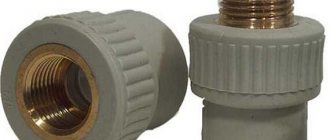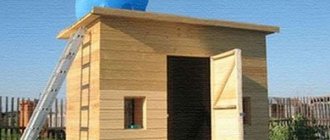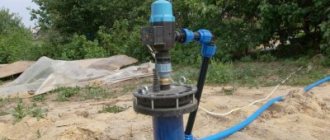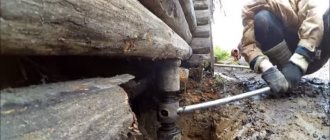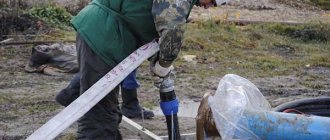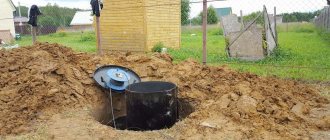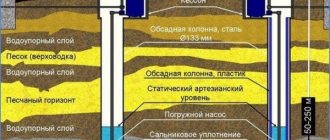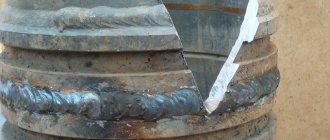- high load-bearing capacity on the ground and on the support material
- immersion of piles to a depth of up to 45 meters and in some cases even deeper, which is not possible with the pile driver method of immersion
- in the manufacture of BNS there are no powerful dynamic impacts through the soil on the foundations of neighboring buildings (as during driving), therefore this method is widely used in Moscow and other cities with dense buildings
- when installing a BPS, the strength properties of clay soils are preserved
- provide the installation of a pile foundation in water-saturated, quicksand soils, with a high level of groundwater filtration (when using casing pipes).
High load-bearing capacity is ensured by immersion to great depths in the soil, where, according to the results of geological surveys, denser layers were discovered.
And also with a diameter reaching 1500 mm, which gives a large support area. The disadvantages include a significantly higher manufacturing cost.
the choice of this technology is justified in the following cases:
- The foundation of a massive building requires piles of increased load-bearing capacity.
- It is necessary to immerse piles in water-saturated soils.
- Construction is being carried out in an area of dense urban development in close proximity to neighboring buildings, especially those with dilapidated foundations, as well as old buildings of architectural value or cultural monuments.
- The existing and operated complex network of underground structures and communications (metro tunnels, water pipelines and sewerage systems) above which the construction site is located does not allow the use of the cheaper pile-drive method of foundation construction.
—>
Classification and design of bored piles
Bored piles are reinforced concrete structures, the well for installation of which is formed by drilling. A typical bored support structure consists of two elements - a concrete body and a reinforcement cage.
For reinforcement of piles, ready-made, factory-produced reinforcement cages are used. The frame type is longitudinal-transverse; it consists of vertical reinforcing bars that are connected by horizontal jumpers. To create a longitudinal contour, corrugated reinforcement is used, produced using the hot-rolled method (class A1-A3). The diameter of the rods is selected based on the size of the pile; it can vary between 12-20 mm.
The fixing crossbars are made of smooth reinforcement (diameter 8-15 mm). The frame connection is made by electric arc welding. After joining, the frame is coated with a protective primer to prevent corrosion.
According to the design features, there are two types of bored piles:
- Cylindrical;
- With widened support sole.
Cylindrical piles have the same cross-section along the entire length of the trunk, while in widened piles the lower part of the trunk has an increased diameter. Due to the increased support area, such supports receive increased stability in the ground and greater load-bearing capacity.
The widening can be formed by two methods - through the use of special drill strings with folding cutters or the camouflage method, in which an explosive is placed at the bottom of the well and its subsequent detonation is carried out.
What are bored piles?
Bored piles are a method of driving piles that consists of drilling a hole and filling it with concrete. Concreting is done using metal reinforcement. In private suburban construction, depending on the soil, formwork may or may not be installed (on stable soils, where there is no risk of crumbling inside the walls of the well, formwork is not needed). In larger-scale construction, casing pipes are used for the same purpose.
Basic technologies for constructing bored piles
On dry and low-moisture rocks
When working with dry soil, the risk of collapse of the well walls increases several times. Mostly, piles up to 30 meters long with a diameter of 40-120 cm are made from dry rocks, used to create foundations for small residential buildings.
Drilling for piles in low-moisture soils is carried out using the rotational method using a bucket drill or auger. To avoid rock collapse, the wellhead is fixed using a metal pipe. After the soil has been drilled to the required level, a cavity is created using an expander at the base of the future pile - after filling with concrete, it will act as the heel of the pile and take on the main load. After drilling is completed, a reinforced frame is inserted into the well, then using a concrete pipe, the entire structure is secured with a concrete mixture. As soon as the pouring is completed, the finished pile is compacted using a vibrator fixed to the concrete pipe. An inventory jig is used to form the pile head.
On waterlogged and unstable soils
When creating piles in unstable rocks with a high groundwater content, the borehole walls are stabilized using a flushing fluid supplied under pressure. To create a well, rotary or percussion drilling is used; when working on soils with rock inclusions and aquifers, a hydraulic grab or drill bit can be used.
When working on waterlogged soils, a special hollow auger is used for bored piles, which allows a stabilizing clay suspension to be pumped into the well under pressure. Thanks to the filtration phenomenon, a protective shell is formed on the walls of the well, protecting them from collapse. Both bentonite and local clay can be used to mix the washing liquid; the density of the solution is set in accordance with the characteristics of the rock at the site. To ensure that the used flushing liquid does not pollute the construction site, a system of gutters located on a slope is used to drain it. Another way to stabilize the walls of a well is to supply water, the excess pressure of which fixes the walls of the well.
After the well is prepared, a reinforced frame and a concrete pipe with a bottom valve, which is a rubber membrane with a spring fastening, are lowered into it. After the pipe is lowered into the well and concrete supply begins, the valve automatically opens. In order to quickly remove the pipe from the well being filled, it is recommended to use casing pipe models with quick-release clamps.
Using casing pipes
Fixing the walls of the well with casing pipes is one of the most popular alternatives to the use of drilling fluid, suitable for work in all types of soil. Depending on the project, after completion of the work, the casing can remain in the well as a reinforcing structure or be removed to the surface for further use.
In most cases, a rotary drilling technique is used to create a cased hole for bored piles. The first stage of work is the creation of a pioneer well, the length of which is equal to the length of one casing module. To install the next sections of pipe, the remaining sections of the well are drilled one after another until the desired elevation is reached. The individual casing modules are connected to each other using welds or bolted joints. A reinforced frame and a concrete pipe supplying the cement mixture are inserted into the finished well. As concrete arrives, the casing pipe is removed to the surface, and the body of the pile is compacted and expanded in diameter. The final stage of work is the creation of the pile head.
Using CFA technology (using a continuous hollow screw)
Western technology for constructing bored piles using a continuous hollow auger makes it possible to create super-strong load-bearing structures and is used in cases where increased demands are placed on the load-bearing capacity and the time frame for completing the work is very limited.
To drill a well, a hollow auger with valves and holes is used to release the flushing fluid and concrete mixture. After the rock is drilled to the desired level, the supply of the flushing solution stops, and a concrete mixture begins to flow into the auger under pressure, displacing the lighter bentonite suspension from the well. Supplying concrete under pressure allows you to increase the density of the pile body, and the output of the concrete mixture directly from the auger allows you to reduce work time and minimize the risk of collapse of the borehole walls, even when working with low-cohesion dry soils. After the pouring is completed, a reinforced frame for bored piles is inserted into the concrete-filled hole using a vibratory driver - this technology makes it possible to remove all air voids and achieve the highest possible load-bearing capacity of the pile.
Features of the technology
In construction, bored foundations are becoming increasingly popular. This is explained by the advantages of this technology, which allows the construction of structures on almost any soil. Features of bored piles include:
- Wide range of application, possibility of use on both dense and unstable soils (heaving or loose soils, near water bodies).
- Fast construction of the foundation. Technology using bored piles makes it possible to complete all work faster than pouring a strip base or Swedish slab.
- Built in compliance with all standards, the foundation on bored piles will last at least 150 years.
- Simplicity of design due to the relatively small volume of excavation work; it is enough to drill wells.
- The ability to independently select the diameter and height of the supports, the type of reinforcement, depending on the properties of the soil and the design features of the building.
- Increased load-bearing capacity. Such a foundation can support the weight of multi-story, industrial buildings, and massive reinforced concrete structures.
The diameter of the pile is selected in accordance with the current SNiP after geodetic surveys, taking into account climatic and geological features. Directly during design, the mass of the building, the number of supports are calculated and the type of soil is determined. Information on the bearing capacity of bored piles on different soils can be found in the table:
Bored foundation technology has disadvantages, which include:
- use of heavy equipment for drilling, installation of casing pipes, reinforcement at large construction sites;
- relative complexity of technological processes;
- the need for calculations.
Technologies and methods used for constructing bored piles
Standard scheme for installing bored piles
| 1. Immersion of the casing string into the ground | 2. Extracting soil from the casing | 3. Immersion of the reinforced frame into the well | 4. Filling the well with concrete | 5. Removing casing pipes |
Gentle technologies that can be used today in the construction of various objects make it possible to build a foundation absolutely safely for neighboring buildings.
Bored piles have long been considered perhaps the most convenient method for such purposes. Their diameter is 0.3-2.5 meters, and the length of the piles starts from 1 meter.
To increase the load-bearing capacity, it is possible to make piles of a special type, which widen slightly in their lower part (widening the heel of the pile). This type is used at sites where the loads on the structure are excessively high, or poorly compressible soils lie quite deep.
When installing bored piles, you do not need a lot of free space
Contrary to prejudices in this regard, in order to start building a project, it is not at all necessary to have a large space.
After all, bored piles are often used to strengthen the foundation of a building during reconstruction, as well as in construction - as a special type of foundation or as fencing pits. There are other cases in which the use of this method is relevant; you can check with our consultants about them.
What is the advantage of bored piles, the arrangement of which, by the way, does not take much time?
- There is no dynamic impact on nearby soils and structures;
- the possibility of organizing spot construction projects;
- spot drilling of wells into sand to create an autonomous water supply system in dacha and suburban areas;
- high level of reliability, thanks to which you can accurately control the drilling process as soon as the bearing layer is reached;
- the ability to extract or drill out boulders found at depth;
- Exercising direct control during the drilling process over the compliance of all geological and engineering conditions.
PPR for piling work
2.2.1. The dry method of installing bored piles is used in conditions of cutting through stable cohesive soils, when wells do not float or collapse after drilling and during concreting. The technological diagram of the installation of such piles is shown in Fig. 2.2.1.
Rice. 2.2.1. Diagram of the installation of bored piles with a widened heel using the dry method: I - auger drilling with a diameter of 400-600 mm; II - arrangement of a widened cavity using an expander; III - installation of the conductor - inventory formwork and reinforcement cage; IV - lowering the funnel with a concrete pipe; V - filling the well with a concrete mixture of class B20 - B25 (M200-M300) with a draft, cone 10-12 cm; VI - removal of the casing with compaction of concrete by back-and-forth movements of the pipe and formation of the pile head; 1 - jib crane; 2 — mounted drilling equipment type SO-2; 3 - borehole; 4 - expander; 5 - jig-formwork; 6 - reinforcement frame; 7 — funnel (hopper) with concrete pipe; 8 vibration bucket; 9 — widened heel
2.2.2. It is recommended to carry out work on the installation of bored piles in a cluster arrangement in pits, trenches or on leveled areas with marks for the base of grillages, single column piles or support columns - on planned areas with marks 0.15 m below the level of the basement or first floor floor a building without a basement, and in areas covered with water - from the surface of artificial islands.
2.2.3. Wells are drilled using self-propelled drilling machines, sets of attachments or any other installations that allow drilling a well with a diameter of less than 400 mm to the depth specified by the project. When installing and centering the drilling rig, displacements in plan and deviations of the vertical axis of the rod from the design position of the pile axis are not allowed.
2.2.4. During the drilling of each well, it is necessary to visually determine the correspondence of the soil at the base of the pile with that specified in the project (by name, density and humidity). In case of discrepancy, drilling should be stopped and representatives of the design institute and the customer should be called to resolve the issue of changing the drilling depth.
2.2.5. Breaks when drilling a well without casing pipes, as well as between the completion of drilling the well and drilling out the expansion, are allowed for no more than 8 hours. In this case, a mandatory control check of the safety of the well and expansion is carried out with cleaning of the face with a bucket drill, which is recorded in the log of the pile device.
2.2.6. After drilling is completed, the depth of the well is measured using a drill string (columns), a rack or a lot. Then a conductor-formwork with a casing pipe is installed (Fig. 2) and the bottom (bottom of the well) is cleaned by rotating a cylindrical bucket with knives and slots in the hinged bottom.
Rice. 2.2.2. Forming the pile head using inventory formwork: 1 - inventory collapsible metal formwork; 2 - reinforcement frame; 3 - concrete pile head
2.2.7. A conductor with a casing pipe may not be installed in cases where the cohesive soil at the wellhead is sufficiently stable, the earth's surface is cleared of loose soil and its spillage is excluded, the funnel (hopper) with a concrete pipe rests directly on the earth's surface, compressing the soil at the wellhead.
2.2.8. In wells without widening, instead of cleaning the bottom, it is allowed to compact the base by compacting a layer of crushed stone or hard concrete 15-20 cm thick using some kind of balancer, chisel or hydraulic stamp. In this case, the walls of the well must be secured with an inventory casing pipe.
2.2.9. Drilling of the expansions is carried out using a four-milling mechanical reamer with a cylindrical bucket (Fig. 2.2.3). In the folding bottom of the tub there are knives for cleaning the bottom of the well and slots through which soil shavings enter the tub. Mechanical expanders must have limiters for opening the articulated knife blades to the required heel diameters of 1200, 1400, 1600, 1800 mm, as well as stoppers for holding the opening of the blades and rotation of the tub. Rice. 2.2.3. Four-mill reamer for creating a widened cavity using the dry drilling method
2.2.10. Before starting work, the expander is calibrated, which consists of the following: on the surface of the ground, the expander blades are sequentially opened to the required diameters with the corresponding measurement of the lowering of the rod; At the same time, the reliability of the stoppers holding the opening of the blades and the rotation of the bucket is checked.
2.2.11. If the expander is not suitable for installing stoppers, then clearing the soil at the bottom of the well can be done with another bucket of opening blades or a bucket drill with a cut-off ripper.
2.2.12. The design position and size of the widened heel of a bored pile is determined by the constant level of support of the bucket in the bottom of the well, which requires mandatory cleaning of the soil in the face before drilling out the widening with lifting the expander and unloading the soil on the surface of the earth. Measuring the depth of the well after cleaning the bottom is carried out using a special measuring tape, a lot, or by markings on the drill rod, for which two marks are applied to the rod with paint or chalk: the lower mark corresponds to the depth of the well after lowering the reamer with the tub touching the bottom of the well and should be at the level surface of the earth; the upper line corresponds to the mark of the prepared lowering of the rod; it shows the full opening of the knife blades of the expander to the required diameter.
2.2.13. Before drilling the expansion, the bottom of the tub must rest at the design depth of the well bottom, while the lower mark on the drill rod must be at the level of the wellhead (ground surface), which is checked using a ruler laid on a board at the wellhead or some other fixation.
2.2.14. If the position of the lower mark turns out to be higher, this indicates a possible spill of soil into the bottom of the well and a rise in the level of support of the tub (Fig. 4). Then, before drilling, the expander should be raised, the bucket and knife blades should be stopped, and the face should be cleaned using knives in the bottom of the bucket. Then the column with the expander is raised and the soil is unloaded from the bucket. Only after this are the stoppers removed from the tub and the expansion drilling cycle is allowed. Rice. 2.2.4. Drilling out the expansion without clearing loose soil at the bottom of the well
2.2.15. The lowering of the column with the expander must be carried out at a minimum speed with strict centering of the column in order to avoid spilling soil from the walls and blades of the expander.
2.2.16. In the process of drilling out the widening, it is advisable to fill the bucket with soil to 3/4 of the height. In this case, before lifting and unloading the expander bucket on the surface of the ground, the column should be raised and lowered in height by 0.8-1.0 m 2-3 times in order to dump soil from the blades into the bucket.
2.2.17. To ensure that loose soil does not remain at the base of the widened heel, the cycles of clearing the face and drilling out the widening should alternate and end with cleaning.
2.2.18. Drilling of the expansion ends when the upper mark on the rod lowers and is at ground level. Despite the simplicity of the device, in many cases, due to incomplete clearing of loose soil in the bottom of the well and on the support area of the expansion, the bearing capacity of piles with a widened heel is often reduced to 50% compared to high-quality expansions.
2.2.19. The drilled widening before installing the reinforcement frame and concreting must be selectively checked and accepted by the customer's technical supervision or designer's supervision. The specified diameter of the widening is checked by landing the calibrated rod to the mark, which fixes the full opening of the expander blades.
2.2.20. The quality of cleaning the base and the safety of the arch of the widening should also be checked by the workman (foreman) by inspecting the face with a light bulb.
2.2.21. The journal for installing bored piles must indicate the elevation of the hole bottom, the diameter of the widened heel, the date and time of drilling the widening and concreting, and the signature of the foreman or foreman.
2.2.22. Reinforcing cages with a length less than the depth of the well should be suspended from the pile formwork or transverse beams.
2.2.23. Concreting of reinforced piles (supports) with a widened heel, and without widening with a diameter of up to 600 mm, should be done by supplying the concrete mixture through a funnel (hopper) with a concrete-cast pipe with an outer diameter of 25-30 mm less than the inner diameter of the reinforcement frame and a length of 0.5- 0.6 m more than the length of the frame.
2.2.24. With sufficiently stable walls of boreholes and unreinforced piles without widening or reinforced only in the upper part of the shaft with short rods, as well as reinforced piles (supports) with a diameter of more than 600 mm, concreting should be done by freely dumping the concrete mixture through a funnel with a concrete pouring pipe with a diameter of 325-350 mm, 2-3 m long without limiting the height of the drop (set by the construction organization in agreement with the customer’s technical supervision).
2.2.25. For concreting, a concrete mixture of a class corresponding to the project should be used, but not lower than B15 (M200) with a cone draft of 10-12 cm.
2.2.26. For concreting unreinforced piles with a diameter of 600 mm or more, it is permissible to use a concrete mixture of plastic consistency with a cone settlement of 6-8 cm, discharged through a conductor or funnel with a concrete nozzle with mandatory compaction of the concrete in the head part with an in-depth electric vibrator (vibrating mace or vibrating needle).
2.2.27. The size of gravel for making concrete piles should be no more than 40 mm, and crushed stone - 30 mm.
2.2.28. It is recommended to deliver concrete mixture directly into a funnel or bunker using concrete mixer trucks. When delivering the mixture by dump trucks, it should be unloaded into a vibrating bucket with a sector gate, and supplied to the well with a jib crane.
2.2.29. If a ready-mixed concrete mixture is used, delivered to the site by dump trucks, then cement with a setting period of at least 2 hours must be used for its preparation.
2.2.30. The consistency of the concrete mixture should be checked directly at the concreting site using a cone. Deviation from the specified mobility is allowed within ±20 mm.
2.2.31. The mobility of the mixture must be maintained for the time required for transportation and compliance with normal concreting conditions. The water separation of the mixture, which characterizes its cohesion, should be within 1-2%.
2.2.32. Bored piles must be concreted without interruption. The volume of concrete mixture supplied through the concrete-casting pipe must be sufficient to fill the well with a slight excess of the elevation of the pile head and to compensate for the decrease in the level of concrete when removing the pipe due to filling the annulus and shrinkage during hardening.
2.2.33. In cases of interruption in concreting the shaft for more than 2 hours, the casing or concrete pipe should not be removed. In such cases, it is left in the body of the pile, the top layer of exfoliated concrete in the pipe is removed and concreting is completed after delivery of the concrete mixture, regardless of the break period.
2.2.34. If, during a break in concreting, the concrete pipe is raised above the concrete level to the well or is completely removed, and then the shaft is finished with concrete without clearing loose earth and weak concrete, then such a pile should be considered defective and an additional one should be appointed in its place.
Go to the main page of the “Installation of bored piles” section.
Technology for installing bored piles with casing
In loose, water-logged, landslide-prone and unstable soils, the well is protected with a casing pipe. The drill makes the hole equal to the diameter of the casing pipe. The casing pipe, under its own weight, or by rotating in the direction opposite to the auger, or by mechanical pressing, is immersed into the well to the designed depth, and the drill and remaining soil are removed.
Rice. 4 Driving bored piles
The next stage is filling the casing with concrete - for concrete piles or installing a reinforcing steel frame for reinforced concrete ones. The reinforcement is installed in the center of the well to obtain a protective layer of 60 - 70 mm. Then the concrete solution is poured and compacted. As the well is filled, the casing is removed.
If rack piles are made, then the lower part of the well is widened for their support. This soil is either removed with a special device up to 1.5 - 3 well diameters, or in camouflage wells it is compacted by explosion. In the mid-twentieth century, electric pulse multiple hydraulic shocks began to be used for this purpose.
Support device using an auger
Drilled piles can be installed using a hollow auger. This method makes it possible to lay a support of any depth. This process occurs in several stages:
- Using a hollow drill with a closed working end, a shaft is made for the installation of a pile.
- Having reached the required depth, the drill is stopped and at the same time the supply of solution and the drill start to reverse.
- A frame made of reinforcement rods is placed into the fresh concrete solution using a vibrating press.
When constructing a foundation using the hollow auger method, it is possible to reduce the distance between supports to a minimum, since the effect of vibration on the soil is not significant.
Technology for constructing bored piles
The main parameter that determines the calculations is the bearing capacity. It depends on the characteristics of the soil, the diameter of the bored piles and their length, and the total load from the future structure.
When determining the load from the structure, you need to add up the masses of all components of the structure: walls, roof, engineering structures and add temporary loads - snow (depending on the region, the coefficients are in 2.01.07.85 SP) and useful load (additional load depending on the purpose of the roof).
When calculating the piles themselves, several factors are taken into account:
- diameter of the bored pile;
- length (immersion depth);
- brand of solution;
- quantity and parameters of reinforcement.
For example, bored piles with a diameter of 300 mm (soil - hard clay):
- height – 2 meters;
- concrete M100;
- vertical ribbed reinforcement – 6 rods of 1.2 cm each;
- smooth horizontal – 0.6 cm;
- step between piles – 1 meter;
- load-bearing capacity – 4.242 tons.
500 mm bored piles with the same other parameters will have a load-bearing capacity of 11.775 tons.
Bored piles with a diameter of 800 mm, bored piles with a diameter of 1000 mm and more are used for the construction of heavy industrial structures and multi-storey city buildings. The bearing capacity of reinforced concrete piles with a large cross-section can reach up to 600 tons.
We have extensive experience in installing structures made from bored piles with any permissible load. As well as our own design department, which will take care of all the calculations for your facility, starting with the design of the pile field and ending with the prompt (one day) preparation of estimates.
Advice from professionals
Despite the fact that you can make a bored foundation yourself, during construction there are many aspects known only to experienced builders who share their experience. To avoid mistakes during construction, pay attention to the following points:
- carefully study the type of soil, for which it is better to perform geodetic reconnaissance, taking into account the information received when selecting the diameter and depth of installation of piles;
- for private construction, do not use supports with a diameter of more than 200 mm, since their installation will require special equipment, which will make the foundation more expensive;
- when pouring casing pipes, part of the reinforcement should protrude to the height of the future grillage to give it additional strength;
- the grillage can be poured only after the mortar in the bored piles has completely set;
- the distance between the bottom of the grillage and the ground surface should not be less than 150 mm so that it does not deform during swelling.
The construction of foundations from bored piles is a technology that is gaining popularity. It allows you to create a durable and inexpensive foundation for both private houses, light structures, and industrial buildings on any soil. The costs of constructing such a foundation are lower than those of constructing a classic strip foundation, buried below the freezing level of the soil, by an average of 40%. Strength and durability indicators remain comparable.
Installation of bored piles
Installation of bored piles with your own hands
Traditional strip and slab foundations are increasingly giving way to pile foundations. Houses on stilts turn out to be no worse, but the cost of such a foundation is cheaper, and the ease of installation allows you to complete all stages of the work yourself. If it comes to an area with increased water saturation, uneven terrain, slopes or problematic soil, bored piles will help. This foundation is an excellent alternative to any type of foundation.
Design Features
do-it-yourself bored piles The main feature of bored piles is that the elements are not driven into the ground by force, they “grow” into the soil by drilling wells and pouring concrete mixture
There are many advantages of a bored pile foundation:
- ability to work in densely built conditions;
- reduced dynamic loads on adjacent foundations;
- small amount of land work;
- practicality;
- all-season construction;
- the ability to do the work yourself;
- functionality of the base on any type of soil;
- long service life.
The main feature of bored piles is that the elements are not driven into the ground by force, they “grow” into the soil by drilling wells and pouring concrete mixture. Simply put, a casing pipe is placed into a hole in the soil and filled with solution. Weak-bearing soils require just such a foundation, since with this method the support falls on the lower dense layers with minimal compression function.
The practiced reliable and slightly higher cost option of constructing a drilled pile foundation with insulation can reduce the risk of destruction due to natural soil movements. Work is carried out using expanded polystyrene, which has a rigid structure. The sheets are laid out on a waterproofing layer, followed by sprinkling with soil. In case of heaving, the polystyrene foam sheet will cushion and prevent possible movements.
Areas of application
The presented equipment is used in the following cases:
- for the construction of tall and bulky industrial and office buildings;
- when constructing facilities on swampy areas or other weakened soils;
- for the construction of houses on difficult terrain;
- when hard rocks that can withstand the load of a building lie quite deep.
Bored piles, unlike driven and screw piles, have a more reliable design and are not subject to corrosion. The requirements for foundations are described in the Code of Practice SP 24.13330.2011, in accordance with which the work must be carried out.


